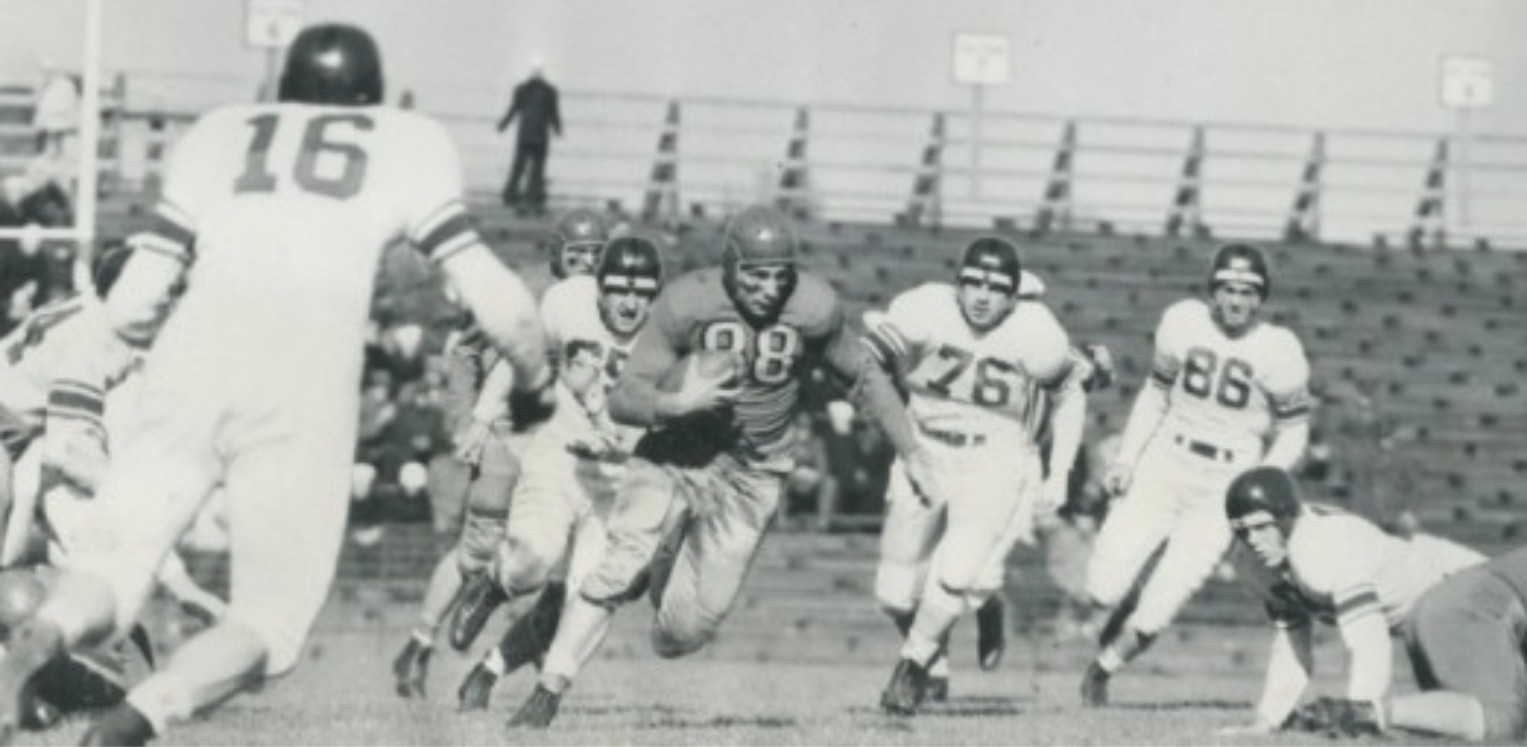The 1942 College Football Season

November, 29 2023
One of the most appealing aspects of college football is following the weekly climb and fall of teams in the rankings as they aspire to reach the national championship. While only three teams were ever perched on top of the poll in 1942, the climb to number one that year had more than its share of twists and turns.
As the coaches poll did not begin until 1950 there was only the Associated Press writers’ poll. There was no pre-season poll. The first vote came after week 4. Ohio State was #1, followed by Georgia, Michigan, Alabama, and Illinois. Georgia and OSU remained #1 and #2 until the November 2 poll.
Georgia did become #1 after the Halloween Day game between #1 Ohio State and #6 Wisconsin. With men being transported all over the country to various military outposts rail transportation was overtaxed. When Ohio State needed some rail cars to travel to Madison, they could not find any. But stashed away on a sidetrack were some old cars that had not been used in years. They dusted off the cars and sent the Buckeyes north. But they failed to clean out the car’s water tanks. The infected water was home to numerous parasites and by the time OSU got to Madison half the team was weakened, ill to the point where 21 players felt the effects of the “Bad Water Game of 1942.” The Buckeyes were also placed high up in a hotel with no elevator and surrounded by hard partying Badger fans. The result was a 17-7 Wisconsin victory. The Badgers were no slouch as they finished the year at #3 and had three Hall of Fame players: Dave Schreiner, Pat Harder, and Elroy “Crazylegs” Hirsch. Schreiner’s entire uniform is on display in the HOF. The Big Ten MVP later gave his life at Okinawa.
The new ratings of November 2 had a top six of: Georgia, Wisconsin, Georgia Tech, Notre Dame, Boston College, and Ohio State. That week Wisconsin lost to Iowa 6-0, a week later Michigan beat Notre Dame and a week after that Ohio State beat Michigan. The same week that Ohio State beat Michigan, #1 Georgia lost to unranked Auburn 27-13. The circumstances of the loss came from some astute Auburn scouting. Georgia’s best player was Heisman Trophy winner Frank Sinkwich. Tiger assistant coach Shug Jordan noticed from watching films that Sinkwich had a slight mannerism that tipped off if he was going to run or pass.
Going into the final week of the season the poll now had Boston College first, followed by Georgia Tech, Ohio State, Wisconsin, and Georgia. All BC had to do to claim the national title was to beat their lowly crosstown rival Holy Cross (4-4-1). Eagle fans were so sure of the win and the national title they set up a victory celebration for that night at the Coconut Grove night club. In one of the biggest upsets in college football history, the Crusaders beat the Eagles 55-12. The victory celebration was cancelled and averted what could have become one of college football’s greatest tragedies. That night the Coconut Grove was overcrowded, doors locked and barred, and a fire resulted in the death of 492 people.
Some 900 miles to the south, # 2 Georgia Tech was beset with a tragic yet less deadly day. The Yellow Jackets were led by a freshman back named Clint Castleberry who finished third in the Heisman vote. Georgia shut down Castleberry, a back Notre Dame coach Frank Leahy thought was the best in the country and beat Tech 34-0. Like Schreiner, Castleberry gave his life in WWII. He was co-pilot of a B-26 on a mission in Africa. His plane never made its destination and was never found.
Meanwhile in Columbus, Ohio State beat Iowa Pre-Flight 41-12. Iowa Pre-Flight was one of numerous WWII training facilities that had football teams. In 1943 the AP decided to include military training teams in the rankings and Iowa Pre Flight was #2. Training team rosters included college players from all over the country and professional players as well. The Seahawks were coached by Bernie Bierman, the Minnesota coach who had five national championship teams with the Gophers.
The final poll come out as it started with Ohio State at #1 followed by Georgia, Wisconsin, Tulsa and Georgia Tech.
You may ask, “What about the bowls?” They didn’t count in 1942 and didn’t begin to count until 1965. Why? Well, there are numerous reasons. 1) Bowls were thought of more as a reward in 1942 and almost-but not quite like what they call in soccer as “friendlies”. 2) A great deal of the country didn’t send teams to bowls. The Big Ten, the Ivy League, Notre Dame, Army, Navy didn’t go to bowls and only the Pacific Coast champion went to a bowl. When given the option of playing in a bowl game often players voted no. “Coach, I have not been home since August, I miss my girlfriend, I’d like to spend Christmas with my family and if I don’t do well on my exams, I’ll never get into Law school.” Or “the people in New Orleans/Miami/Dallas tell us we can’t bring our African American players. – to hell with them!”
So, the rules in 1942 were that bowl games do not count. Georgia beat # 13 UCLA (7-4) 9-0 in the Rose Bowl. Of the top ten teams: Ohio State, Wisconsin, Notre Dame, and Michigan sat at home listing to Bing Crosby records around the fireplace at Christmas along with nine other top 20 teams.